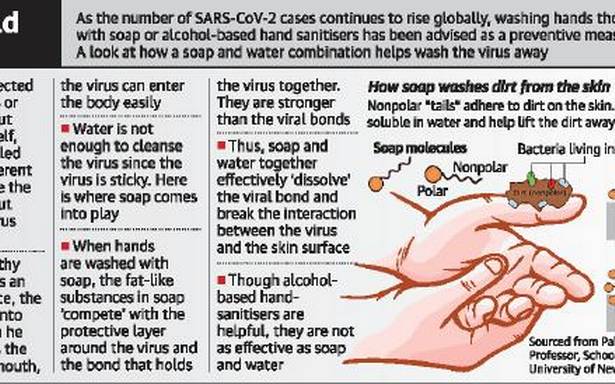The story so far: Ever since the novel coronavirus (SARS-CoV-2) outbreak began in China in end-December 2019, various measures have been mentioned to reduce the risk of infection. Guidelines by the World Health Organization specify that one of the ways to reduce the risk of infection is by regularly and thoroughly cleaning one’s hands with an alcohol-based hand rub or washing them with soap and water. Regular washing becomes important as the virus tends to be viable from hours to more than a day on different surfaces that are regularly touched with hands.
Also read: Coronavirus | India shares two SARS-CoV-2 genome sequences
How does washing with soap help get rid of the coronavirus?
The grime on our hands contains innumerable viruses and bacteria. Washing with water without using soap helps reduce the amount of microbes but does not remove most of the virus and bacteria completely. Using soap, therefore, becomes far more effective in removing microbes.
Viruses such as coronavirus, influenza-causing viruses, Ebola, Zika have their genetic material encased in a layer of fat called the lipid envelop. Soap molecules are pin-shaped with a head that is water-loving (hydrophilic) and a tail that is oil-loving (oleophilic). Being oleophilic, the tail portion of the molecule tends to have an affinity for and ‘competes’ with the lipids in the virus envelope. Since the chemical bonds holding the virus together are not very strong, the long oleophilic tail gets inserted into the envelope and tends to have a ‘crowbar’ effect that breaks the lipid envelope of the virus. The tail also competes with the bond that binds the RNA and the lipid envelop thus dissolving the virus into its

